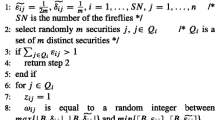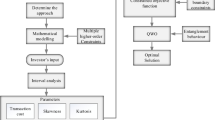Abstract
Due to the complexity of the financial market, security returns are sometimes expressed by expert estimates rather than historical data. In this paper, we deal with a multiobjective multiperiod portfolio selection problem based on uncertainty theory. We propose a new uncertain multiobjective multiperiod mean-semisentropy-skewness portfolio optimization model, in which uncertain semi-entropy is used to quantify the downside risk. To be more realistic, several constraints are also considered, such as the transaction costs, cardinality, liquidity, budget, and bound constraint. Moreover, a novel hybrid technique, called the MFA-SOS algorithm, which combines the features of the firefly algorithm (FA) and symbiotic organism search algorithm (SOS) is designed to solve the proposed model. Finally, a numerical example is given to illustrate the effectiveness of the proposed approach.



Similar content being viewed by others
References
Markowitz H (1952) Portfolio selection. J Finance 7(1):77–91
Sharpe WF (1964) Capital asset prices: a theory of market equilibrium under conditions of risk. J Finance 19(3):425–442
Atsushi Y (1996) The mean-variance approach to portfolio optimization subject to transaction costs. J Oper Res Soc Jpn 19(1):425–442
Markowitz H (1959) Portfolio selection: efficient diversification of investments. Wiley, New York
Konno H, Yamazaki H (1991) Mean-absolute deviation portfolio optimization model and its applications to Tokyo stock market. Manage Sci 37(5):519–531
Jorion P (1996) Risk2: Measuring the risk in value at risk. Financial Anal J 52(6):47–56
Rockafellar RT, Uryasev S (2000) Optimization of conditional value-at-risk. J Risk 2 (3):1071–1074
Philippatos GC, Wilson CJ (1972) Entropy, market risk, and the selection of efficient portfolios. Appl Econ 4(3):209–220
Nawrocki DN, Harding WH (1986) State-value weighted entropy as a measure of investment risk. Appl Econ 18(4):411–419
Simonelli MR (2005) Indeterminacy in portfolio selection. Eur J Oper Res 163(1):170–176
Zhou JD, Li X, Pedrycz W (2016) Mean-semi-entropy models of fuzzy portfolio selection. IEEE Trans Fuzzy Syst 24(6):1627–1636
Chen W, Wang Y, Mehlawat MK (2018) A hybrid FA-SA algorithm for fuzzy portfolio selection with transaction costs. Ann Oper Res 269:129–147
Mansour N, Cherif MS, Abdelfattah W (2019) Multi-objective imprecise programming for financial portfolio selection with fuzzy returns. Expert Syst Appl 138:112810
zhou J, Li X (2020) Mean-semi-entropy portfolio adjusting model with transaction costs. J Data Inf Manag 2:121–130
Zadeh LA (1965) Fuzzy sets. Inf Control 8(3):338–353
Liu BD (2007) Uncertainty theory, 2nd edn. Springer, Berlin
Qin ZF (2015) Mean-variance model for portfolio optimization problem in the simultaneous presence of random and uncertain returns. Eur J Oper Res 245(2):480–488
Liu BD (2010) Uncertainty theory: a branch of mathematics for modeling human uncertainty. Springer, Berlin
Zhai J, Bai M (2018) Mean-risk model for uncertain portfolio selection with background risk. J Comput Appl Math 330:59–69
Chen W, Wang Y, Gupta P, Mehlawat MK (2018) A novel hybrid heuristic algorithm for a new uncertain mean ł́cvarianceł́cskewness portfolio selection model with real constraints. Appl Intell 48 (9):2996–3018
Wang XT, Huang XX (2019) A risk index to model uncertain portfolio investment with options. Econ Model 80:284–293
Li B, Sun YF, Aw G, Teo KL (2019) Uncertain portfolio optimization problem under a minimax risk measure. Appl Math Model 76:274–281
Huang XX, Yang TT (2020) How does background risk affect portfolio choice: an analysis based on uncertain mean-variance model with background risk. J Bank Financ 111:105726
Huang XX, Qiao L (2012) A risk index model for multi-period uncertain portfolio selection. Inf Sci 217:108–116
Li B, Zhu Y, Sun Y, Aw G, Teo KL (2018) Multi-period portfolio selection problem under uncertain environment with bankruptcy constraint. Appl Math Model 56:539–550
Chen W, Li DD, Liu YJ (2018) A novel hybrid ICA-FA algorithm for multiperiod uncertain portfolio optimization model based on multiple criteria. IEEE Trans Fuzzy Syst 27(5):1023–1036
Zhang P (2019) Multiperiod mean absolute deviation uncertain portfolio selection with real constraints. Soft Comput 23(13):5081–5098
Chen W, Li DD, Lu S, Liu WY (2019) Multi-period mean-semivariance portfolio optimization based on uncertain measure. Soft Comput 23(15):6231–6247
Chang TJ, Meade N, Beasley JE, et al. (2000) Heuristics for cardinality constrained portfolio optimisation. Comput Oper Res 27:1271–1302
Deng GF, Lin WT, Lo CC (2012) Markowitz-based portfolio selection with cardinality constraints using improved particle swarm optimization. Expert Syst Appl 39(4):4558–4566
Gong DW, Han YY, Sun JY (2018) A novel hybrid multi-objective artificial bee colony algorithm for blocking lot-streaming flow shop scheduling problems. Knowl Based Syst 148:115–130
Gong DW, Sun J, Ji XF (2013) Evolutionary algorithms with preference polyhedron for interval multi-objective optimization problems. Inf Sci 233:141–161
Gong DW, Xu B, Zhang Y, Guo YN, Yang SX (2020) A similarity-based cooperative co-evolutionary algorithm for dynamic interval multiobjective optimization problems. IEEE Trans Evol Comput 24 (1):142–156
Xu B, Gong DW, Guo YN, Rong M (2018) Environment sensitivity-based cooperative co-evolutionary algorithms for dynamic multi-objective optimization. IEEE/ACM Trans Comput Biol Bioinform 15 (6):1877–1890
Zhang Y, Gong DW, Ding ZH (2011) Handling multi-objective optimization problems with a multi-swarm cooperative particle swarm optimizer. Expert Syst Appl 38(11):13933–13941
Wang B, Li Y, Wang S, Watada J (2018) A multi-objective portfolio selection model with fuzzy value-at-risk ratio. IEEE Trans Fuzzy Syst 26(6):3673–3687
Chen W, Xu W (2019) A hybrid multiobjective bat algorithm for fuzzy portfolio optimization with real-world constraints. Int J Fuzzy Syst 21(1):291–307
Silva YLT, Herthel AB, Subramanian A (2019) A multi-objective evolutionary algorithm for a class of mean-variance portfolio selection problems. Expert Syst Appl 133:225–241
Kaucic M (2019) Equity portfolio management with cardinality constraints and risk parity control using multi-objective particle swarm optimization. Comput Oper Res 109:300–316
Liagkouras K (2019) A new three-dimensional encoding multiobjective evolutionary algorithm with application to the portfolio optimization problem. Knowl Based Syst 163:186–203
Yang XS (2008) Nature-inspired Metaheuristic algorithms. Luniver Press, UK
Fan BB, Yang WW, Zhang ZF (2019) Solving the two-stage hybrid flow shop scheduling problem based on mutant firefly algorithm. J Ambient Intell Humaniz Comput 10(3):979– 990
Wang CH, Nguyen TT, Pan JS, Dao TK (2017) An optimization approach for potential power generator outputs based on parallelized firefly algorithm. In: Proceeding of the twelfth international conference on intelligent information hiding and multimedia signal processing, pp 297–306
Yang XS (2013) Multiobjective firefly algorithm for continuous optimization. Eng Comput 29 (2):175–184
Marichelvam MK, Prabaharan T, Yang XS (2014) A discrete firefly algorithm for the multi-objective hybrid flowshop scheduling problems. IEEE Trans Evol Comput 18(2):301–305
Karthikeyan S, Asokan P, Nickolas S, Page T (2015) A hybrid discrete firefly algorithm for solving Multi-Objective flexible job shop scheduling problems. Int J Bio-Inspir Com 7(6):386–401
Hidalgo-Paniagua A, Vega-rodríguez MA, Ferruz J, Pavón N (2017) Solving the multi-objective path planning problem in mobile robotics with a firefly-based approach. Soft Comput 21:949–964
Bozorg-Haddad O, Garousi-Nejad I, Loáiciga H A (2017) Extended multi-objective firefly algorithm for hydropower energy generation. J Hydroinformatics 19(5):734–751
Nguyen TT, Pan JS, Chu SC, Roddick JF, Dao TK (2016) Optimization localization in wireless sensor network based on multi-objective firefly algorithm. JNI 1(4):130–138
Lu S, Zhang N, Qiu Y, Gao Y (2019) A multi-period regret minimization model for uncertain portfolio selection with bankruptcy constraint. J Intell Fuzzy Syst 37(6):8417–8439
Cheng MY, Prayogo D (2014) Symbiotic organisms search: a new metaheuristic optimization algorithm. Comput Struct 139:98–112
Chu SC, Du ZG, Pan JS (2020) Symbiotic organism search algorithm with multi-group quantum-behavior communication scheme applied in wireless sensor networks. Appl Sci 10(3):930
Kumar S, Tejani GG, Mirjalili S (2019) Modified symbiotic organisms search for structural optimization. Eng Comput 35(4):1269–1296
Tran DH, Cheng MY, Prayogo D (2016) A novel multiple objective symbiotic organisms search (MOSOS) for time–cost–labor utilization tradeoff problem. Knowl Based Syst 94:132–145
Tejani GG, Pholdee N, Bureerat S, Prayogo D (2018) Multiobjective adaptive symbiotic organisms search for truss optimization problems. Knowl Based Syst 161:398–414
Abdullahi M, Ngadi MA, Dishing SI, Ahmad BI, et al. (2019) An efficient symbiotic organisms search algorithm with chaotic optimization strategy for multi-objective task scheduling problems in cloud computing environment. J Netw Comput Appl 133:60–74
Tejani GG, Pholdee N, Bureerat S, Prayogo D, Gandomi AH (2019) Structural optimization using multi-objective modified adaptive symbiotic organisms search. Expert Syst Appl 125:425–441
Wolpert DH, Macready WG (1997) No free lunch theorems for optimization. IEEE Trans Evol Comput 1(1):67–82
Chen W, Wang Y, Zhang J, Lu S (2017) Uncertain portfolio selection with high-order moments. J Intell Fuzzy Syst 33(3):1397–1411
Markowitz HM, Usmen N (1996) The likelihood of various stock market return distributions, part 2: empirical results. J Risk Uncertainty 13:221–247
Scott RC, Horvath PA (1980) On the direction of preference for moments of higher order than the variance. J Finance 35(4):915–919
Sun Q, Yan YX (2003) Skewness persistence with optimal portfolio selection. J Bank Financ 27(6):1111–1121
Amihud Y (2002) Illiquidity and stock returns: cross-section and time-series effects. J Financial Mark 5(1):31–56
Yelghi A, Köse C (2018) A modified firefly algorithm for global minimum optimization. Appl Soft Comput 62:29–44
Zhang J, Teng YF, Chen W (2019) Support vector regression with modified firefly algorithm for stock price forecasting. Appl Intell 49(5):1658–1674
Devaney R (2018) An introduction to chaotic dynamical systems. CRC Press
Deb K, Pratap A, Agarwal S, Meyarivan T (2002) A fast and elitist multiobjective genetic algorithm: NSGA-II. IEEE Trans Evol Comput 6(2):182–197
Bacanin N, Tuba M (2014) Firefly algorithm for cardinality constrained mean-variance portfolio optimization problem with entropy diversity constraint. Sci World J 2014:721521
Pouya AR, Solimanpur M, Rezaee MJ (2016) Solving multi-objective portfolio optimization problem using invasive weed optimization. Swarm Evol Comput 28:42–57
Jin X, Chen N, Yuan Y (2019) Multi-period and tri-objective uncertain portfolio selection model: a behavioral approach. North Am J Econ Finance 47:492–504
Zhang QF, Li H (2007) MOEA/D: a multiobjective evolutionary algorithm based on decomposition. IEEE Trans Evol Comput 11(6):712–731
Corne DW, Jerram NR, Knowles JD, Oates MJ (2001) PESA-II: Region-based selection in evolutionary multiobjective optimization. In: Proceedings of the genetic and evolutionary computation conference (GECCO), pp 283–290
Mirjalili S, Lewis A (2016) The whale optimization algorithm. Adv Eng Softw 95:51–67
Askarzadeh A (2016) A novel metaheuristic method for solving constrained engineering optimization problems: crow search algorithm. Comput Struct 169:1–12
Pan WT (2012) A new fruit fly optimization algorithm: taking the financial distress model as an example. Knowl Based Syst 26(26):69–74
Van DA, Gary V, Lamont B (1999) Multiobjective evolutionary algorithm research: a history and analysis. Evol Comput 8(2):125–147
Zitzler E, Deb K, Thiele L (2000) Comparison of multiobjective evolutionary algorithms: Empirical results. Evol Comput 8(2):173–195
Schott JR (1995) Fault tolerant design using single and multicriteria genetic algorithm optimization. Cell Immunol 37:1–13
Chen W, Xu HL, Jia L, Gao Y (2020) A machine learning model for Bitcoin exchange rate prediction using economic and technology determinants. Int J Forecast. https://doi.org/10.1016/j.ijforecast.2020.02.008
Jiang M, Jia L, Chen Z, Chen w (2020) The two-stage machine learning ensemble models for stock price prediction by combining mode decomposition, extreme learning machine and improved harmony search algorithm. Ann Oper Res. https://doi.org/10.1007/s10479-020-03690-w
Acknowledgements
This research was supported by the Young Academic Innovation Team of Capital University of Economics and Business of China (No. QNTD202002), the Humanity and Social Science Foundation of Ministry of Education of China (No. 19YJAZH005), and the special fund of basic scientific research business fees of Beijing Municipal University of Capital University of Economics and Business (No. XRZ2020016).
Author information
Authors and Affiliations
Corresponding author
Additional information
Publisher’s note
Springer Nature remains neutral with regard to jurisdictional claims in published maps and institutional affiliations.
Rights and permissions
About this article
Cite this article
Lu, S., Zhang, N. & Jia, L. A multiobjective multiperiod mean-semientropy-skewness model for uncertain portfolio selection. Appl Intell 51, 5233–5258 (2021). https://doi.org/10.1007/s10489-020-02079-3
Accepted:
Published:
Issue Date:
DOI: https://doi.org/10.1007/s10489-020-02079-3




